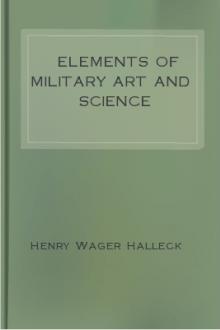Elements of Military Art and Science by Henry Wager Halleck (books you have to read txt) 📕

- Author: Henry Wager Halleck
- Performer: -
Book online «Elements of Military Art and Science by Henry Wager Halleck (books you have to read txt) 📕». Author Henry Wager Halleck
We have as yet had but little experience in the use of war-steamers. The Fulton, four guns, built in 1838-'39, cost three hundred and thirty-three thousand seven hundred and seventy dollars and seventy-seven cents; the Mississippi and Missouri, ten guns each, built in 1841, cost about six hundred thousand dollars a piece; making an average cost for war-steamers of over sixty thousand dollars per gun. The cost of repairs of steam ships will be much greater than those for vessels of war; but we have not yet had sufficient experience to determine the exact amount. It has been estimated, however, by competent judges, that when kept, the expense of repairs will at least equal twelve per cent. of the first cost. The expense of keeping them in commission is enormously great. "Their engines," says the Secretary of the Navy, in his annual report in 1842, "consume so much fuel as to add enormously to their expenses; and the necessity that they should return to port, after short intervals of time, for fresh supplies, renders it impossible to send them on any distant service. They cannot be relied on as cruisers, and are altogether too expensive for service in time of peace. I have therefore determined to take them out of commission, and substitute for them other and less expensive vessels."
The average cost of permanent fortifications is but little more than three thousand dollars per gun. And it must be obvious, from the nature of the materials of which they are constructed, that the expense of their support must be inconsiderable. It is true that for some years past a large item of annual expenditure for fortifications has been under the head of "repairs;" but much of this sum is for alterations and enlargements of temporary and inefficient works, erected anterior to the war of 1812. Some of it, however, has been for actual repairs of decayed or injured portions of the forts; these injuries resulting from the nature of the climate, the foundations, the use of poor materials and poor workmanship, and from neglect and abandonment. But if we include the risk of abandonment at times, it is estimated, upon data drawn from past experience, that one-third of one per cent. per annum, of the first cost, will keep in perfect repair any of our forts that have been constructed since the last war.
But it is unnecessary to further discuss this question We repeat what has already been said, no matter what may be the relative cost of ships and forts, the one, as a general thing, cannot be substituted for the other. Each has its own sphere of action, and each will contribute, in its own way, to the national defence; and any undue increase of one, at the expense of the other, will be attended by a corresponding diminution of national power.[25]
[25]
For further information concerning our system of sea-coast defences, the reader is referred to House Doc. 206, twenty-sixth Congress, second session; Senate Doc. 85, twenty-eighth Congress, second session; and to the annual reports of the Chief Engineer.
CHAPTER VIII.OUR NORTHERN FRONTIER DEFENCES.
In discussing engineering as a branch of the military art, we spoke of the use of fortifications on land frontiers, and their influence on the strategic operations of a campaign. A brief notice was also given of the different systems that have been proposed for arranging these defensive works. Let us now apply this discussion to our northern frontier.
The principle laid down by Napoleon and Jomini, "that fortifications should always be constructed on important strategic points," is undoubtedly the correct one: but how to determine these points is a question that will often perplex the patience and try the skill of the engineer; yet determine them he must, or his fortifications will be worse than useless; for a fort improperly located, like a cannon with its fire reversed on its own artillerists, will be sure to effect the destruction of the very forces it was designed to protect.
The selection of positions for fortifications on our northern frontier must have reference to three distinct classes of objects, viz.: the security, first, of the large frontier towns, where much public and private property is exposed to sudden dashing expeditions of the foe, made either on land or by water; second, of lake harbors, important as places of refuge and security to our own ships, or to the enemy's fleets while engaged in landing troops or furnishing supplies to an invading army; third, of all strategic points on the probable lines of offensive or defensive operations. These objects are distinct in their nature, and would seem to require separate and distinct means for their accomplishment; nevertheless, it will generally be found that positions selected with reference to one of these objects equally fulfil the others, so intimately are they all connected. To determine the strategic points of a probable line of military operations is therefore the main thing to be attended to in locating fortifications. That such points of maximum importance are actually marked out by the peaceful or hostile intercourse of nations cannot be doubted.
The relative importance of cities and towns is less varied by the fluctuations of commerce on a land frontier than on the sea-coast. The ever-changing system of "internal improvements," by furnishing new highways and thoroughfares for the transportation of the products of manufacturers and agriculture, either continually varies the relative standing of the seaports already opened, or opens new ones for the exportation of these products, and the importation of foreign articles received in exchange. But these "internal improvements" are seldom carried so far as to connect together two separate and distinct countries, and consequently the principal places on the dividing line usually retain their relative importance, no matter how often they may have declined during times of hostility, or again flourished with the increased commercial intercourse which results from peace. The principal European places of traffic near the frontiers have remained the same for ages, and in all probability ages hence the great frontier marts will be nearly the same as at present. This stability of rank among border towns is not confined to commercial influence; the same holds true with respect to that established by intercourse of a hostile character. Military history teaches us that lines of hostile operations, and the fields upon which the principal battles between any two countries have been fought, are nearly the same, no matter how remote the periods of comparison. These points and lines, so important in commerce as well as in war, result from the natural features of the ground, and we ought therefore to expect that they would be as little liable to sudden changes as the character of the earth itself.
From these remarks it will readily be perceived that there are three distinct methods of determining the strategic points between this country and Canada: 1st, by an examination of the topography of the two countries; 2d, by tracing out the main channels of commercial intercourse; 3d, by reviewing the lines of their military operations. The last method is the least liable to error, and perhaps is the most easily understood, inasmuch as it is sometimes difficult to point out the precise degree of connection between prospective military lines and the channels of commerce, or to show why these two have a fixed relation to the physical features of the country. In the present instance, moreover, this method furnishes ample data for the formation of our decision, inasmuch as the campaigns between this country and Canada have been neither few in number nor unimportant in their character and results.
In tracing out the main features of the early wars upon our northern frontier, it must be borne in mind that nearly the same portion of country which is now possessed by the English, was then occupied by the French, and that the English possessions in North America included the present Middle and Northern States. At the period of the American revolution the French and English had completely changed ground, the armies of the former operating in the "States," while the English were in possession of Canada.
The first expedition to be noticed against that portion of the country, was conducted by Samuel Argall, who sailed from Virginia in 1613, with a fleet of eleven vessels, attacked the French on the Penobscot, and afterwards the St. Croix.
In 1654, Sedgwick, at the head of a small New England army, attacked the French on the Penobscot, and overrun all Arcadia.
In 1666, during the contest between Charles II. and Louis XIV., it was proposed to march the New England troops across the country by the Kennebec or Penobscot, and attack Quebec; but the terrors and difficulties of crossing "over rocky mountains and howling deserts" were such as to deter them from undertaking the campaign.
In 1689, Count Frontenac, governor of Canada, made a descent into New York to assist the French fleet in reducing that province. His line of march was by the river Sorrel and Lake Champlain. An attack upon Montreal by the Iroquois soon forced him to return; but in the following January a party of French and Indians left Montreal in the depth of a Canadian winter, and after wading for two and twenty days, with provisions on their backs, through snows and swamps and across a wide wilderness, reached the unguarded village of Schenectady. Here a midnight war-whoop was raised, and the inhabitants either massacred or driven half-clad through the snow to seek protection in the neighboring towns.
In 1690, a congress of the colonies, called to provide means for the general defence, assembled at New York, and resolved to carry war into Canada: an army was to attack Montreal by way of Lake Champlain, and a fleet to attempt Quebec by the St. Lawrence. The former advanced as far as the lake, when the quarrels of the commanding officers defeated the objects of the expedition. The Massachusetts fleet of thirty-four vessels, (the largest carrying forty-four guns each,) and two thousand men, failed to reduce Quebec, though the defences of that place were then of the slightest character, and armed with only twenty-three guns.
In 1704, and again in 1707, Port Royal was attacked by costly expeditions fitted out by the eastern colonies; and again, in 1709, a land force of fifteen hundred men advanced against Montreal by Lake Champlain; but nothing of importance was effected by either expedition.
In 1711, Lord Bolingbroke planned the conquest of Canada. The land forces, numbering five thousand men in all, were separated into two distinct armies, the one sent against Detroit, and the other against Montreal by Lake Champlain; while a fleet of fifteen ships of war, forty transports, and six store-ships, carrying a land force of six thousand five hundred men, was to attack Quebec. The maritime expedition failed to reach its destination, and after losing a part of the fleet and more than a thousand men in the St. Lawrence, this part of the project was abandoned. Nor was any thing important accomplished by either division of the land forces.
The same plan of campaign was followed in 1712. An army of four thousand men marched against Montreal by Lake Champlain, but on hearing of the failure of the naval expedition and of the concentration of the French forces on the river Sorel, they retired towards Albany.
The next expedition of any importance was the naval one of 1745 against Louisburg. For the attack of this place the colonies raised about four thousand men, and one hundred small vessels and transports, carrying between one hundred and sixty and two hundred guns. They were afterwards joined





Comments (0)